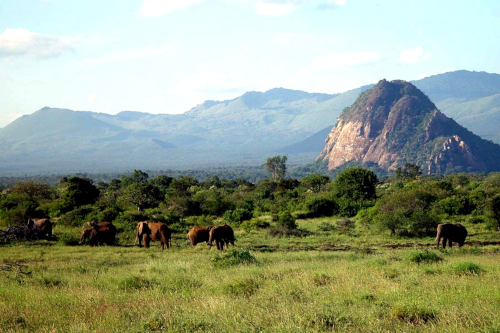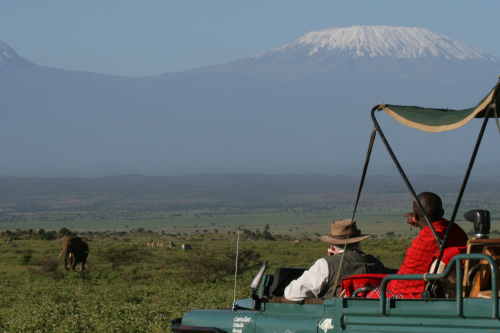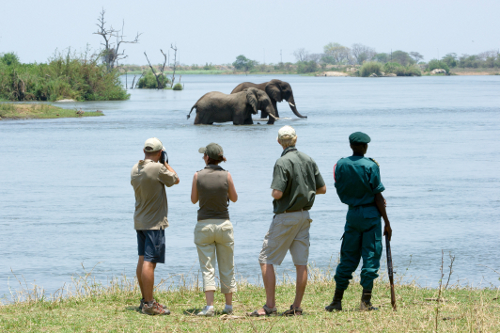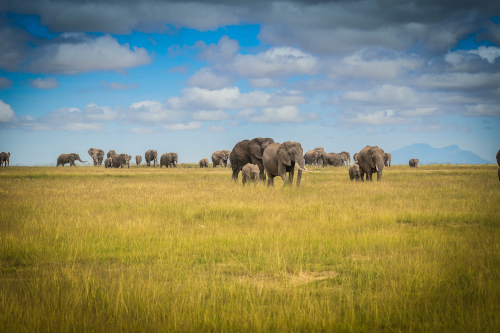Let's Talk About The Elephants in the Room
/Updated. First published 11/8/2019
Every year, on 12th August, World Elephant Day brings together cause-related organisations, businesses and concerned individuals to raise awareness of, and conservation funds for, the plight of the Elephant and sustainable solutions for addressing its dwindling global wild population of an estimated 415,000 African plus around 42,000 Asian elephants.
World Elephant Day was conceived in 2011 by Canadian filmmakers Patricia Sims and Michael Clark, and Sivaporn Dardarananda of the Elephant Reintroduction Foundation in Thailand, and officially founded and launched on August 12, 2012.
Since 2011, the peak of poaching, the world is losing more elephants than the population can reproduce, also due to loss of habitat due to human environmental pressures. With more elephants being killed than born, their increasing decline threatens the species’ future.
“The question is, are we happy to suppose that our grandchildren may never be able to see an elephant except in a picture book?”
What are the impacts of rapidly declining elephant populations?
Around 90% of African elephants have been killed in the past century, mainly due to the profitable ivory trade, but also for meat and body parts.
Bull elephants with big tusks are the main targets and their numbers have been diminished to less than half that of the females. Female African elephants also have tusks and are killed, leaving an increasing number of orphaned baby elephants. This impacts the stability of matriarchal elephant societies, especially given ‘an elephant never forgets’: The elephant is the largest existing land mammal, has the largest brain and is known to be smart, sentient, socially complex and empathetic.
Elephants are one of the world’s most iconic species and a keystone species, which means they play a unique and crucial role in the way their ecosystem functions: Like the keystone in an arch, although the keystone is under the least pressure of any of the stones in an arch, the arch collapses without it.
Relative to their abundance, keystone species have a disproportionately large impact on their natural environment. Without them, the ecosystem would dramatically change or cease to exist altogether. They make it possible for a myriad of plant and animal species to live in their environments as well.
As ‘landscape architects’, herbivore elephants move and feed, creating clearings as they go which let plants grow and forests regenerate naturally, and dispersing seeds they eat over a huge area.
So the loss of elephants gravely affects many species that depend on the elephant- ecosystems and causes major habitat chaos and a weakening to the structure and diversity of nature itself. This means that elephant conservation is also ecosystem conservation, upon whose natural resources man depends, and natural heritage of human communities.
The Elephant on the IUCN Red List
On the IUCN Red List of species, Asian Elephants are categorised as "Endangered", and the previously ‘vulnerable’ single species African Elephant (map range) has now (2021) been categorised as 2 distinct genetic species and separately assessed: the African forest elephant is now ‘Critically Endangered’ and the African savanna elephant as ‘Endangered’. They could all be extinct by the end of the next decade.
The last African elephant census occurred in 2016. Between 2006-2015, around 111,000 African elephants were lost from the wild, mainly due to poaching, plus having lost 30% habitat. Between 2007-2014 30% of Africa's savannah elephants were lost. The 2016 IUCN African Elephant Status Report provides the most recent reliable estimate of the continental population of the two species combined, at around 415,000 elephants.
Elephant Species
Elephantidae is the only surviving family of the order Proboscidea; extinct members include the mastodons and mammoths.
There are 3 species of Elephant currently recognised as mammals of the family Elephantidae:
• The Asian Elephant (Elephas maximus) – Endangered, population decreasing, approx. 40,000
• The African Savanna Elephant (Loxodonta africana) - Endangered, population decreasing. Decreased by at least 60% over the last 50 years
• The African Forest Elephant (Loxodonta cyclotis) - Critically Endangered, population decreasing. Declined by more than 86% over a period of 31 years.
Ancient giant elephants living 1.5 million to 100,000 years ago across Eurasia (before eventually becoming extinct) are more closely related to the African forest elephants of today than the forest elephants are related to African savannah elephants!
Elephants and humans share a long history throughout civilization, though it differs in Africa and Asia, due to their different size and habitat.
Elephants’ pillar-like legs carry their great weight; their trunk (a proboscis) is used for breathing, bringing food and water to the mouth, and grasping objects; their tusks, derived from incisor teeth, serve both as weapons and tools for moving objects and digging; and their large ear flaps help maintain a constant body temperature as well as in communication.
African elephants have larger ears and concave backs, whereas Asian elephants have smaller ears, and convex or level backs.
Both species suffer extensive poaching for their ivory tusks, meat and body parts.
African Elephants – Loxodonta africana & Loxodonta cyclotis
African elephants are found in 37 countries in sub-Saharan Africa, with an estimated 70% in Southern Africa, 20% in Eastern Africa, 6% in Central Africa and 3% in West Africa.
They are extinct in Burundi, Mauritania (savanna) and the Gambia (forest).
The forest elephant is found in: Angola; Benin; Burkina Faso; Cameroon; Central African Republic; Congo; Congo, The Democratic Republic of the; Côte d'Ivoire; Equatorial Guinea; Gabon; Ghana; Guinea; Guinea-Bissau; Liberia; Niger; Nigeria; Senegal; Sierra Leone; South Sudan; Togo.
The savanna elephant is found in: Angola; Botswana; Cameroon; Central African Republic; Chad; Congo, The Democratic Republic of the; Eritrea; Ethiopia; Kenya; Malawi; Mali; Mozambique; Namibia; Nigeria; Rwanda; Somalia; South Africa; South Sudan; Tanzania, United Republic of; Uganda; Zambia; Zimbabwe.
The expanse of the African forests and grasslands habitat, where the African elephant has roamed for 50 million years, and its enormous size and aggression, has allowed the African elephant to resist captivity, unlike the Asian elephant.
They need a lot of land to find enough food and water. They can roam across more than 30,000sq km. But the space available to elephants in Africa has more than halved: African elephants’ range shrank from three million square miles in 1979 to just over one million square miles in 2007, pushing elephants into smaller islands of protected areas and hinder their freedom to roam.
Forest elephants occur in the tropical forests of Central Africa and in a range of habitats in West Africa. They rarely overlap with the range of the savanna elephant, which prefers open country and is found in a variety of habitats in Sub-Saharan Africa including grasslands and deserts.
They’re still doing well in some secure areas, where numbers are even increasing, but in other places they’ve been forced to live in small, isolated herds and numbers are getting dangerously low. Populations in Ivory Coast, Ghana, Guinea, Guinea Bissau, Nigeria, Sierra Leone and Togo have been already wiped out in recent years.
An estimated 100 African elephants killed each day (WorldElephantDay, 2022) by poachers, around 30,000 every year.
In 2013, Conservationist Dr Dame Daphne Sheldrick revealed an elephant was being killed every 15 minutes in Africa to supply an insatiable and unsustainable demand for ivory; revealing their consequential extinction could come as soon as 2025.
In some countries, like Kenya, anti-poaching campaigns and hard work have helped stabilise populations. But this has led to conflict between humans and elephants, so work is being carried out to try and put elephants off human settlement encroachment.
In other places, such as for forest elephants in Mali, West Africa, numbers are at a critical level.
Less than a quarter of elephants actually live in protected areas, and only around 30% of the range of African elephants are officially protected.
And as one of Africa’s wildlife ‘big five’, elephants are popular with tourists, which can be an important source of income for communities.
The Asian Elephant – Elephas maximus
The Asian elephant is listed as an ‘Endangered’ species with around 40,000 remaining worldwide at last estimate in 2008 – less than 10% of the African elephant population - having declined by at least 50% in the three generations (each generation a 25 year time span, the average age of reproductive females).
The Asian Elephant’s habitat ranges over 13 countries: Bangladesh; Bhutan; Cambodia; China; India; Indonesia (Kalimantan, Sumatera); People's Democratic Republic Laos; Malaysia (Sabah, Peninsular Malaysia); Myanmar; Nepal; Sri Lanka; Thailand; Viet Nam.
They have gone extinct in Pakistan.
The Sumatran elephants are critically endangered, with less than 2,800 left in the wild.
In Asia, wild elephant suffer severe habitat loss in some of the most densely human-populated regions on the planet.
Their traditional territories and migration routes have been fragmented by development, highways and industrial monocrops such as palm oil and rubber tree plantations, which have destroyed millions of hectares of forest ecosystems.
Because of this Asian elephants have disappeared from around 85% of the areas where they used to live, leaving elephant populations spread out over smaller areas.
With no access to their natural habitat, elephants are forced into deadly confrontations with humans where neither species wins.
Poaching is perhaps less common in Asia because only some male Asian elephants have tusks, and most females don't have any at all.
“A world without elephants is hard to comprehend, but it is a real possibility. Against a submachine gun or poacher armed with a spear, they stand little chance.”
The Elephant: Now
The escalation of poaching, habitat loss, human-elephant conflict and mistreatment in captivity are just some of the threats to the elephant:
Tradition
The Asian elephant has lived alongside humans for over 4,000 years, revered and admired in tradition and spirituality across many cultures.
In Thailand, the elephant is a national icon: it has a national holiday designated in its honour and elephants can receive a Royal title from the King.
However, in Asia Asian elephants are still poached for body parts, and one out of every three Asian elephants left in the world is a captive animal.
Baby elephants are captured from the wild and sold into the (irresponsible) tourism industry, to be viciously trained in order to ‘break the spirit’ of the elephant, traded, used for entertainment in tourist parks and circuses, and for illegal logging. These captive elephants are often mistreated, abused and confined to sub-standard facilities without adequate veterinarian care. Research suggests they suffer long-term depression over the trauma of their capture and captivity, as well as drastically shortened life spans.
Poaching
Despite a CITES (the Convention on International Trade in Endangered Species) international ivory trade ban since 1990, huge amounts of ivory are smuggled illegally by organised criminal networks and legal trade still exists in many countries such as Japan.
The illegal wildlife trade is recognised as the fourth largest transnational crime by value, after drugs, arms and human trafficking.
It is estimated to be worth up to £15 billion each year and is responsible for decimating populations of elephant, as well as rhino, lion and many other lesser known species.
China, Hong Kong, Thailand and Vietnam, where ivory is seen as a status symbol, all have legal ivory networks which likely cover for illegal trade too.
Between 2010 and 2014, the price of ivory in China tripled, driving illicit poaching through the roof.
Between 2000 and 2016, more than 71,000 kg of ivory were seized in China - equivalent to 10,800 elephants. 2013 saw the greatest quantity of ivory confiscated in the last 25 years.
In May 2021, Bloomberg estimated the value of ivory at $3,300 per pound, the global trade $23 billion annually.
If the elephants are to survive, the demand for ivory must be stopped.
“No one in the world needs an elephant tusk but an elephant.”
Policy changes such as the UK’s in 2015 can help: its laws curb the illegal ivory trade by banning sales if there is no way to verify an item is at least 70 years old. The hope is that if poachers can't sell it, they won't kill the elephants for the ivory.
The UK is also helping to develop ways to use fingerprints left on the ivory to lead them to poachers.
In May 2016, Kenya showed zero-tolerance for the illegal ivory trade by showing the world the largest ivory burn in history and torching 105 tons worth of ivory.
In June 2016, the United States prohibited all commercial import, export, and interstate trade of African elephant ivory with limited exceptions.
In summer 2017, the US ban includes the outlawing of intrastate sale of elephant ivory was added in a number of states.
In January 2018, China banned domestic ivory trade - a historic move shutting down the world's biggest legal ivory market, and plummeting the price of raw ivory.
However, not all countries are responding yet: The EU is not identified as a region of concern regarding illegal ivory trade, and they banned the export of raw ivory, but limiting trade between member states is still a proposal (2021).
Dogs can also be trained to smell poachers, and sniff out illegal wildlife products, which have been boxed up to be send abroad.
Technology also offers opportunities for anti-poaching: GPS tracking to help rangers monitor and protect animals and drones, surveillance and thermal-imaging cameras being set up at waterholes and other common poaching locations.
Incredibly, while tusks are normally found in Asian elephant males and African elephants of both sexes, some female African elephants are now being born without tusks in a genetic mutation caused by poaching. (World Elephant Day)
Elephant Behaviour
Elephants are found in different habitats, such as savannahs, forests, deserts, and marshes. They are herbivorous, and they stay near water when it is accessible.
Given their size, most animals give them a wide berth and even predators such as lions, hyenas, wild dogs and tigers in Asia may only target young calves.
They live in a matriarchal fission–fusion society, in which multiple family groups come together to socialise, the size and composition of the social group changing as time passes and animals move through the environment; animals merge into a group (fusion)—e.g. sleeping in one place—or split (fission)—e.g. foraging in small groups during the day.
Females (cows) tend to live in family groups, which can consist of one female with her calves or several related females with offspring. The groups, which do not include bulls, are led by the (usually) oldest cow, matriarch. Calves are the centre of attention in their family groups and rely on their mothers for up to three years.
Males (bulls) leave their family groups when they reach puberty, and may live alone or with other males. Adult bulls mostly interact with family groups when looking for a mate. They enter a state of increased testosterone and aggression known as musth, which helps them gain dominance over other males as well as reproductive success.
Elephants have the longest gestation period of any animal at almost 22 months. A newborn elephant can weigh up to 260 pounds.
Elephants can live up to 70 years in the wild. They communicate by touch, sight, smell, and sound; using infrasound, and seismic communication over long distances.
An elephant’s trunk has more than 40,000 muscles, more than all the muscles in the human body. They can tear down trees or pick up a blade of grass with their trunks.
Elephant intelligence has been compared with that of primates and cetaceans, who also live in fission–fusion societies. They appear to have self-awareness, and show empathy for dying and dead family members.
Ethical Elephant Tourism Guidelines
It is now known there’s no such thing as an ethical elephant ride or act. If they are behaving a certain way for tourists or an audience (whether carrying or performing in a circus, playing ball, or painting) they will have had their spirit broken in order to be trained this way. Don’t support it.
Genuine sanctuaries are focused first and foremost on supporting elephants, not tourists, and not on breeding. If you suspect they are not, you can report it to animal welfare.
Take Action:
Please support elephants! Can you help conserve and protect them from the numerous threats they face?
Raise Awareness: At a click of a mouse, like and share this article.
Watch: When Giants Fall
Experience: Seeing is believing. Support elephants in non-exploitive and sustainable environments where elephants can thrive under protection. See elephants in the wild with Earth Changers’ partners in Kenya & Malawi.
























